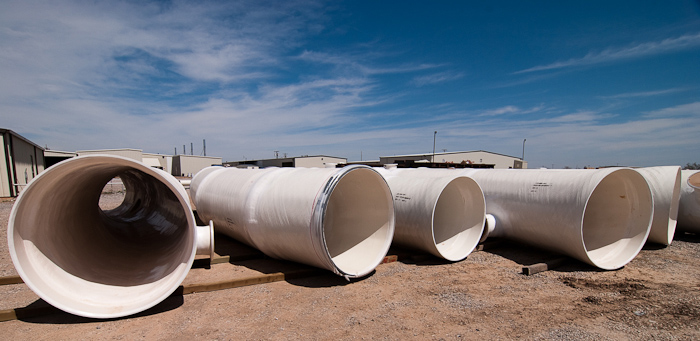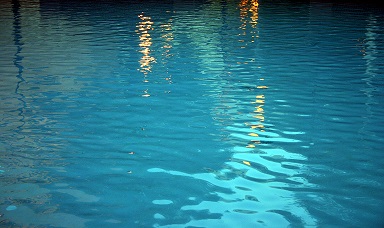General Fiberglass Reinforced Polymer Composition
In this excerpt from our newest eBook Chemical Processing eBook: FRP Applications, Opportunities, and Solutions we share some basic information on the composition of Fiberglass Reinforced Polymers (FRP).
There are four main ingredients that FRP are comprised of: resins, reinforcements, fillers, and additives/modifiers. Each ingredient is equally important and all ingredients play an important role in determining the properties of the finished FRP products. To simplify, think of the resin (polymer) as the glue or the binding agent. The mechanical strength is provided by the reinforcements.
Resins
The primary functions of the resin are to transfer stress between the reinforcing fibers, act as a glue to hold the fibers together, and protect the fibers from mechanical and environmental damage. Resins are divided into two major groups known as thermoset and thermoplastic. Thermoplastic resins become soft when heated, and may be shaped or molded while in a heated semi-fluid state and become rigid when cooled. Thermoset resins, on the other hand, are usually liquids or low melting point solids in their initial form.
Reinforcements: Fibers and Forms
Generally speaking there are four common types of fibers broadly used in the FRP industry: glass, carbon, natural, and arimid. Each has their advantages and applications. Similarly, reinforcements are available in forms to serve a wide range of processes, service and end product requirements. 10
Common materials used as reinforcement include woven roving, milled fiber, chopped strands, continuous chopped, and thermo-formable mat. Reinforcement materials can be designed with unique fiber architectures and be preformed (shaped) depending on the product requirements and manufacturing process.
Fillers
Fillers are used as process or performance aids to impart special properties to the end product. Some examples of inorganic fillers include calcium carbonate, hydrous aluminum silicate, alumina trihydrate, and calcium sulfate. In some circumstances fillers and additives can play a critical role in lowering the cost of compounds by diluting expensive resins and reducing the amount of reinforcements. Furthermore, fillers and additives improve compound rheology, fiber-loading uniformity, enhances mechanical and chemical performance, and reduces shrinkage.
Additives and Modifiers
Additives and modifiers perform critical functions despite their relative low quantity by weight when compared to the other ingredients such as resins, reinforcements and fillers. Some additives used in thermoset and thermoplastic composites include: low shrink/low profile (when smooth surfaces are required), fire resistance, air release, emission control, viscosity control, and electrical conductivity.
An important note is that FRP products can be custom made for their intended use. Understanding the intended function and services of the FRP, will aid the design and manufacturing processes to allow for an optimal finished product (i.e. corrosion resistance). Modifiers can include catalyst, promoters, inhibitors, colorants, release agents and thixotropic agents (i.e. fumed silica and certain clays).
Download our free ebook Chemical Processing eBook: FRP Applications, Opportunities, and Solutions to learn more about FRP.

 April 24, 2013 marks the date of the fourth annual International Corrosion Awareness Day, started by the World Corrosion Organization; who’s mission is to promote education and best practices in corrosion control for the socio-economic benefit of society, preservation of resources, and protection of the environment.
April 24, 2013 marks the date of the fourth annual International Corrosion Awareness Day, started by the World Corrosion Organization; who’s mission is to promote education and best practices in corrosion control for the socio-economic benefit of society, preservation of resources, and protection of the environment.
 What is Flexural Modulus?
What is Flexural Modulus? Every year there are technological advancements. New materials are available today that once were just an idea or considered novel. In
Every year there are technological advancements. New materials are available today that once were just an idea or considered novel. In  CNC stands for Computer Numeric Control. CNC Machining is a process used in the manufacturing sector that involves the use of computers to control machine tools. Tools that can be controlled in this manner include lathes, mills, routers and grinders.
CNC stands for Computer Numeric Control. CNC Machining is a process used in the manufacturing sector that involves the use of computers to control machine tools. Tools that can be controlled in this manner include lathes, mills, routers and grinders. The CNC process is relatively straightforward. First, a CAD drawing is created (either 2D or 3D), second, a code is created that the CNC machine will understand. The program is loaded and finally an operator runs a test of the program to ensure there are no problems. This trial run is referred to as “cutting air” and it is an important step because any mistake with speed and tool position could result in a scraped part or a damaged machine.
The CNC process is relatively straightforward. First, a CAD drawing is created (either 2D or 3D), second, a code is created that the CNC machine will understand. The program is loaded and finally an operator runs a test of the program to ensure there are no problems. This trial run is referred to as “cutting air” and it is an important step because any mistake with speed and tool position could result in a scraped part or a damaged machine. The upfront cost of CNC machines can be steep, but the long-term advantages of
The upfront cost of CNC machines can be steep, but the long-term advantages of  Saves Time and Money—Modern design software allows the designer to simulate the manufacture of his/her idea. There is no need to make a prototype or a model. This saves time and money. One person can supervise many CNC machines as once they are programmed they can usually be left to work by themselves.
Saves Time and Money—Modern design software allows the designer to simulate the manufacture of his/her idea. There is no need to make a prototype or a model. This saves time and money. One person can supervise many CNC machines as once they are programmed they can usually be left to work by themselves. There are many
There are many 
 Fiber Reinforced Polymers (FRP) are unique composite materials in many respects. For starters, they can be formulated to be corrosion, abrasion, and UV resistant, as well as, smoke and fire retardant. FRP are often a cost-effective choice in many industrial applications; they have long life cycles and have demonstrated durability in stringent environments with reduced maintenance costs. Here are five reasons FRP stand out when compared to metals and metal alloys.
Fiber Reinforced Polymers (FRP) are unique composite materials in many respects. For starters, they can be formulated to be corrosion, abrasion, and UV resistant, as well as, smoke and fire retardant. FRP are often a cost-effective choice in many industrial applications; they have long life cycles and have demonstrated durability in stringent environments with reduced maintenance costs. Here are five reasons FRP stand out when compared to metals and metal alloys.



